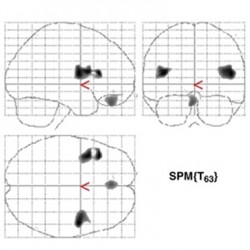By Helen Figueira
June 12, 2009
Time to read: 3 minutes
 CSC study indicates secondary pathology
CSC study indicates secondary pathology
In recent years, a number of studies have shown that the total brain mass of patients with schizophrenia is lower than that in healthy individuals, and that this is especially true of the grey matter made up of neural cell bodies. Previous studies have neglected to to include life-long follow-up studies, however, so it was not known if the observed reduction is the same across the lifespan of the illness.
Now, a paper recently published in Schizophrenia Research by members of the CSC’s PET Methodology and Psychiatric Imaging groups has shown that the relative reduction of grey matter between schizophrenics and healthy control subjects actually diminishes with age, contrary to predictions.
The study by Subrata Bose and co-authors looked at 34 male patients with schizophrenia aged between 27 and 65, and compared the tissue volumes of grey and white matter in their brains with that of 33 healthy male control subjects aged between 18 and 73. Volumes of each tissue type were determined by dividing each scan into an array of voxels (3D pixels) and categorising it as grey matter, white matter or cerebrospinal fluid.
Across the study, it was sound that patients with schizophrenia had overall reduced brain volume (1509 vs 1596 mm3), grey matter ( 755 vs 822 mm3) and white matter volume (525 vs 565 mm3); the latter consists mainly of myelinated axons.
The crucial finding was that total brain matter loss in patients with schizophrenia increasingly comprises white matter as the illness progresses, with 0.67% of white matter lost each year. Contrastingly, the study found that the volume of white matter in the healthy controls actually increased by 0.002% per year; the negligible difference being commensurate with previous studies, which indicate that there is no correlation between age and white matter volume.
The team also found that there was an increase in cerebrospinal fluid in regions adjacent to grey matter loss.
The paper concludes that two pathological effects may be in play: one acting prior to or early on in illness (which reduces grey matter), and another acting as the illness progresses (affecting white matter). This has important implications for understanding the pathophysiology of schizophrenia and related psychological disorders.
Link to the paper in Schizophrenia Research
Ref: Bose, S. K., Mackinnon, T., Mehta, M. A., Turkheimer, F. E., Howes, O. D., Selvaraj, S., Kempton, M. J., Grasby, P. M., May 2009. The effect of ageing on grey and white matter reductions in schizophrenia. Schizophr. Res. (in Press)
Also see: White Matter Matters
This paper has also been written about in:
Medwire